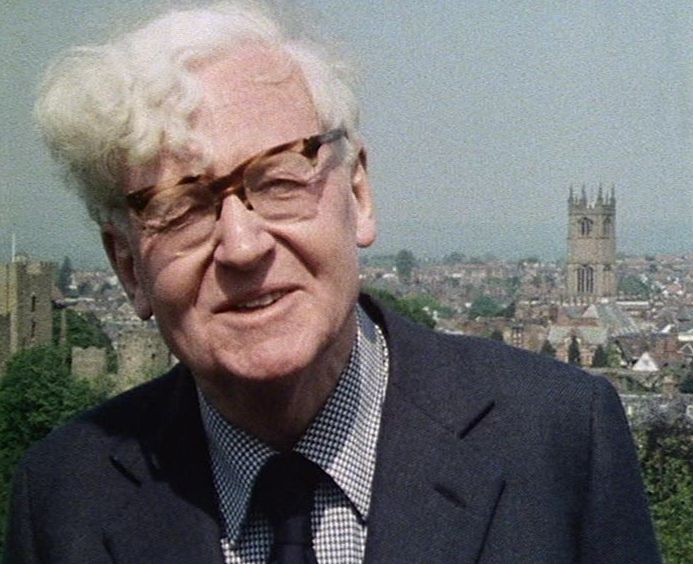
Originally broadcast on BBC2 during August and September 1978, Six English Towns saw Alec Clifton-Taylor cast his experienced eye over the following towns – Chichester, Richmond, Tewkesbury, Stamford, Totnes and Ludlow.
Clifton-Taylor (1907 – 1985) had been a respected, if fairly obscure, architectural historian, so it may have come as something of a surprise to him that fairly late in life he became a recognisable television figure. It’s easy to see why this happened though – he had a pleasingly direct style and his ease in front of the camera meant that he was able to deliver both brickbats and bouquets in an authoritative, but accessible, way. Put simply, Alec Clifton-Taylor had the air of a faintly distracted schoolmaster who dispensed learning lightly but with passion.
At the start of the first edition he sets out exactly what he’s aiming to do. “These are not guidebook programmes. Our main concern will be with buildings and especially with houses. I’d like every programme to be an exercise in looking. Looking at the changing styles and fashions. And at the traditional building materials of England.”
One of Clifton-Taylor’s abiding interests was the way that towns prior to the industrial age used materials which were readily at hand. He therefore had some criticism of the Victorian era, since the age of steam meant that materials could be transported around the country with an ease that simply hadn’t been possible before – therefore the characteristic look of towns began to fade a little.
When visiting Chichester he says that “the cathedral apart, brick and flint are what give Chichester its essential character, the right materials in the right place.” He’s therefore delighted to find examples of good brickwork – and this moment is one that gives pause for thought. We may pass similar buildings each day without giving them a second glance, but one of Clifton-Taylor’s skills was to find interest in what may appear to be commonplace. And after watching the series it’s made me appreciate the buildings in my area a little more – how different styles and eras may exist side by side, for example.
When watching the series now it’s impossible not to wonder how the towns look today. Clifton-Taylor had forthright opinions on how modern buildings (especially high-rise ones) shouldn’t encroach on the old. Sadly, I’m sure that some of the places he visited over the course of three series have lost some of the features which so pleased him. When visiting Richmond, he was taken with the way that the old railway station had been sympathetically turned into a garden centre. He comments that it’s “a shining example of what enterprise and imagination can do to save an excellent building no longer required for its original purpose.” It’s therefore pleasing to note that the building still exists today and – following the closure of the garden centre in 2001 – now serves the community as a heritage centre.
The remainder of the first series has plenty of interest. The House of the Nodding Gables in Tewkesbury, the impressive churches of Stamford and Totnes’ slate decorated houses are just a few examples. The final edition of the series, Ludlow, saw Clifton-Taylor visit his favourite town and there was plenty which appealed to him there. Ludlow exemplifies his concept of a pattern of building – stone for the church, the bridges and the castle, wood for the medieval houses and brick for the houses of the Georgian period. He’s less impressed with some of the Victorian additions though.
Six More English Towns followed three years later in 1981. This time Clifton-Taylor visited Warwick, Berwick-upon-Tweed, Saffron Walden, Lewes, Bradford on Avon and Beverley.
The opening episode has some predictable highlights, such as Warwick Castle, but less well-known buildings – such as Lord Leycester Hospital – are of just as much interest. He wasn’t at all enamoured with the modern council building though – a monstrosity in concrete which obscures views of the impressive-looking church.
Berwick-upon-Tweed finds Clifton-Taylor appreciating the character of the town even if there’s nothing of outstanding importance or interest, although some of the architectural flourishes don’t really meet with his approval. “Even the carved lions on the gate piers seem perplexed”. Elsewhere, he’s not impressed with the amount of traffic which flows through Saffron-Walden, declaring that most of it should be “firmly re-routed.” The series closes with Clifton-Taylor’s visit to Beverley, North Humberside, of which the medieval Minster church is of special interest to him.
A third and final series, Another Six English Towns, would follow in 1984 and this will be issued on DVD in early 2017.
Six English Towns/Six More English Towns won’t be everybody’s cup of tea – a man wanders about looking at buildings – but if you’re interested in history, architecture or English towns then there’s plenty which should catch your attention.
Six English Towns was released on the 12th of September 2016 and Six More English Towns will be released on the 7th of November 2016. Both have a RRP of £19.99.

If only programmes today emulated the scholarship demonstrated in Alec’s programmes. We have found it a real pleasure to re-visit the programmes on the English towns, to learn so much in such a short time and in such a pleasurable fashion.
Producers today – please note! No loud background music to interfere, no showy gimmicks, and such beautiful and correct English!
LikeLike